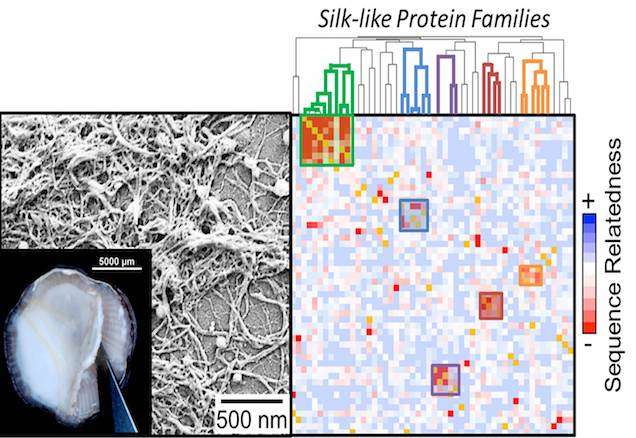Silk-like sequences shape barnacles' permanent adhesive, produce sticky, durable bond

A new study published in Scientific Reports shows how barnacles borrow design cues from insect silks to produce an adhesive that permanently bonds with surfaces underwater, allowing them to survive pounding waves at the rocky shores they often inhabit.
By looking at protein sequences that make up the glue, we find patterns that relate a newly discovered set of adhesive proteins to those used in attachment silks produced by moths and spiders. Barnacles are closer relatives to insects than mussels and tubeworms, and our results suggest that the glue may be organized like arthropod silks, making their familial relationship to spiders, flies and moths more intriguing than previously thought.
Proteins are often described as the molecular workhorse of life. Encoded by a string of amino acids, they perform specialized functions vital to an organism's survival. In the recently published article, NRL researchers have identified a new class of specialized proteins used by barnacles to attach their hard outer shells to surfaces underwater, revealing the chemistry of a material shrouded in mystery for centuries.
NRL's Chemistry Division and the Center for Biomolecular Science and Engineering have applied cutting-edge bioinformatic approaches to establish this new, more comprehensive picture of barnacle adhesive. The sticky material is structured as a mesh of nanoscale fibers resembling coffee filter paper and contains a complex assortment of proteins. New experimental techniques to solubilize the adhesive, combined with bioinformatics approaches similar to those used for genealogical testing, reveal that more than 50 proteins and even enzymes play a role in barnacle cementing— far surpassing the handful previously thought to comprise glue. Many of the barnacle adhesive proteins contain a high percentage of small, flexible amino acids that are arranged in sequences analogous to those used to fold spider and insect silk proteins at the molecular level. The sequences relate barnacle cement to specialized silk materials secreted by arthropods to attach and coat spun threads; these include the silk gum sericin from silkworms and a specialized adhesive silk, spidroin, used by spiders.
Barnacles have evolved a strategy using these materials to achieve their permanent attachment. We find that barnacles use proteins with repetitive, simple sequences to assemble the fibrillar adhesive that bonds them permanently to rocks and ship hulls.
The work performed by NRL researchers defines a new molecular framework for how barnacles use their unique fibrillar adhesive to display chemistries and form a tenacious underwater bond. The findings provide a blueprint for one of nature's strongest glues, and informs new strategies to combat a widespread and costly problem for shipbuilders and sailors around the world.
More information: Christopher R. So et al. Sequence basis of Barnacle Cement Nanostructure is Defined by Proteins with Silk Homology, Scientific Reports (2016). DOI: 10.1038/srep36219
Journal information: Scientific Reports
Provided by U.S. Naval Research Laboratory





















